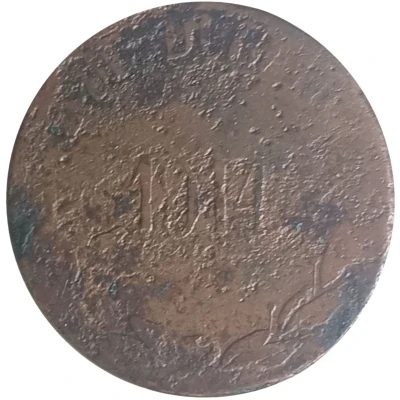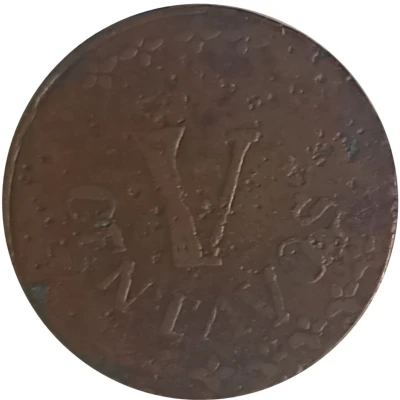


5 Centavos Estado de Durango
1914 year| Copper | 4.61 g | 23.5 mm |
| Issuer | State of Durango |
|---|---|
| Issuing bank | Bank of Durango |
| Type | Standard circulation coin |
| Year | 1914 |
| Value | 5 Centavos (0.05) |
| Currency | Peso (1914) |
| Composition | Copper |
| Weight | 4.61 g |
| Diameter | 23.5 mm |
| Shape | Round |
| Orientation | Medal alignment ↑↑ |
| Demonetized | Yes |
| Updated | 2024-10-06 |
| Numista | N#63150 |
|---|---|
| Rarity index | 94% |
Reverse
The value as large Roman numeral in the center within a circle of four-petal rosettes.
Script: Latin
Lettering:
V
CENTAVOS
Edge
Plain
Comment
There are 4 variants of this coin.
G-B 135: was struck with obverse die I (of VII Durango dies) which has been reworked. A top bar has been added to the first E and the right side of the U has been re-engraved. A new type of reverse was used to strike this and the following coins.
G-B 136: was struck with obverse die II (of VII Durango dies) which had been reworked. The most prominent feature is the retrograded N in DURANGO. The reverse was struck with the same die used for G-B 135.
G-B 137: Utberg-DUR 31a describes & pictures a silver coin of the Roman numeral 5 centavos type in the Sr. Baguette collection. This piece has the obverse die II with retrograded N.
G-B 138: Wood 27(Howland) list this type, struck in lead. His listing is copied by Utberg-DUR 33 and by Gaytan-DGO 34 TER. More information is needed in regard to this listing.
Interesting fact
The 5 Centavos coin from the State of Durango, Mexico, issued in 1914, is interesting because it was made of copper, a metal that was widely used in coinage during that time period. However, what makes this coin stand out is that it was produced during a time of political and social unrest in Mexico, specifically during the Mexican Revolution, which lasted from 1910 to 1920. Despite the turmoil, the coin still maintains its value and is considered a collectible item among numismatists today.